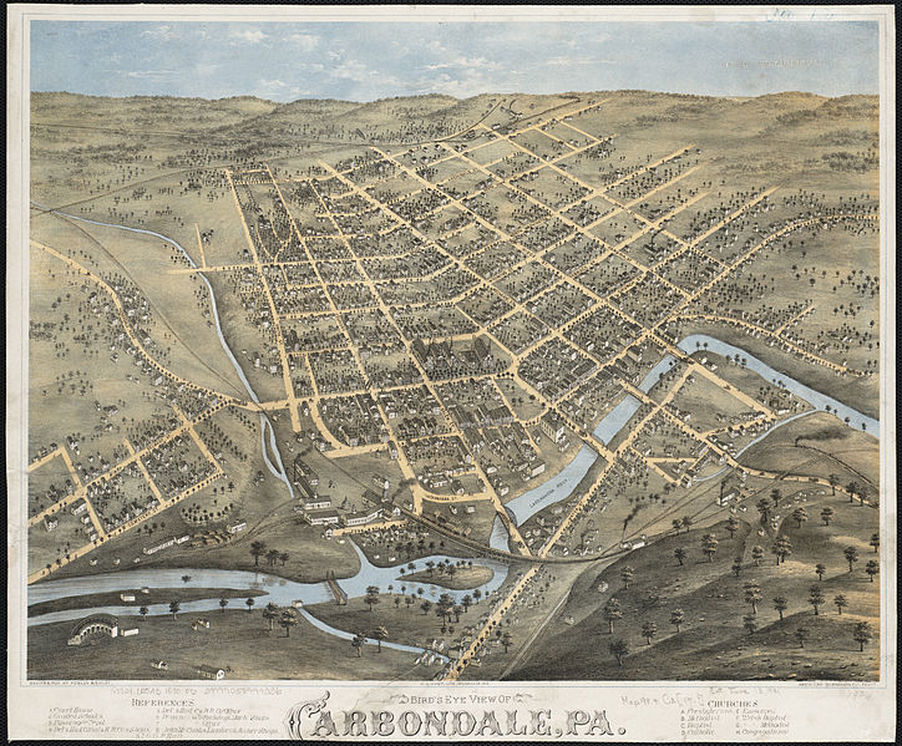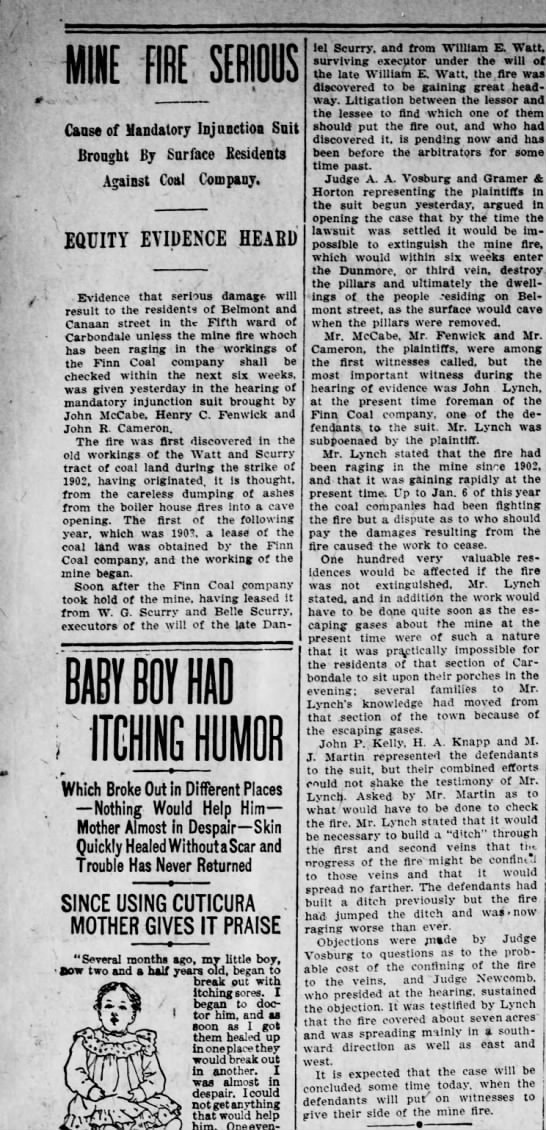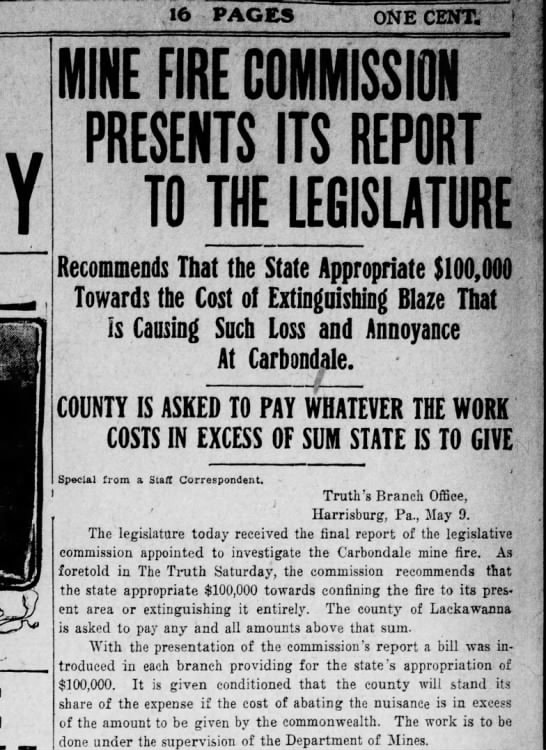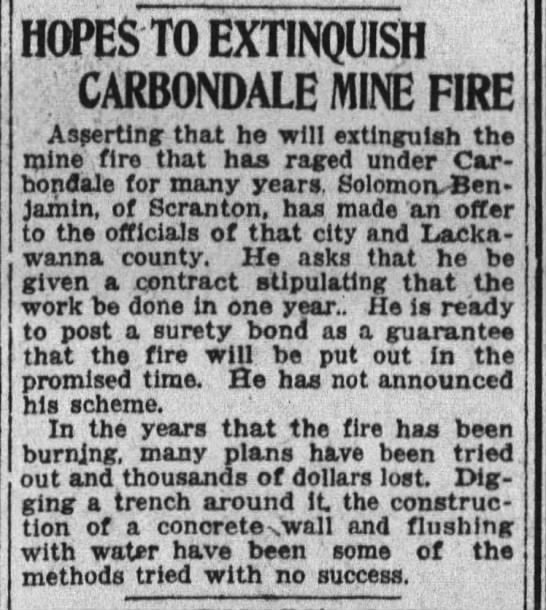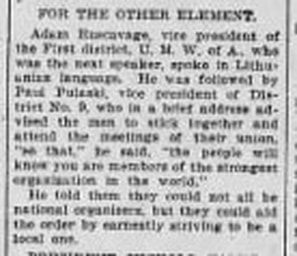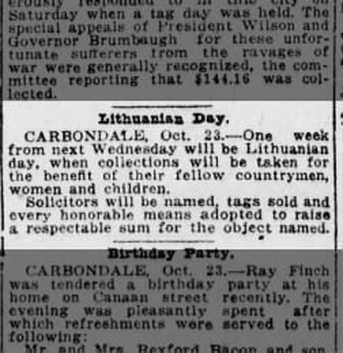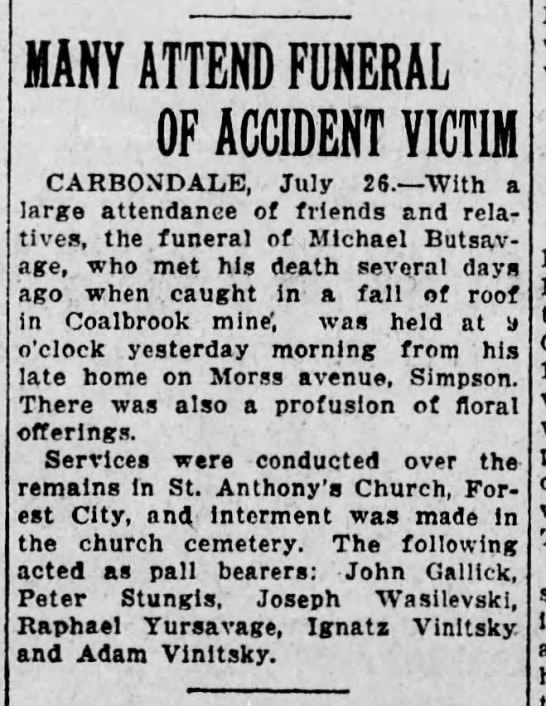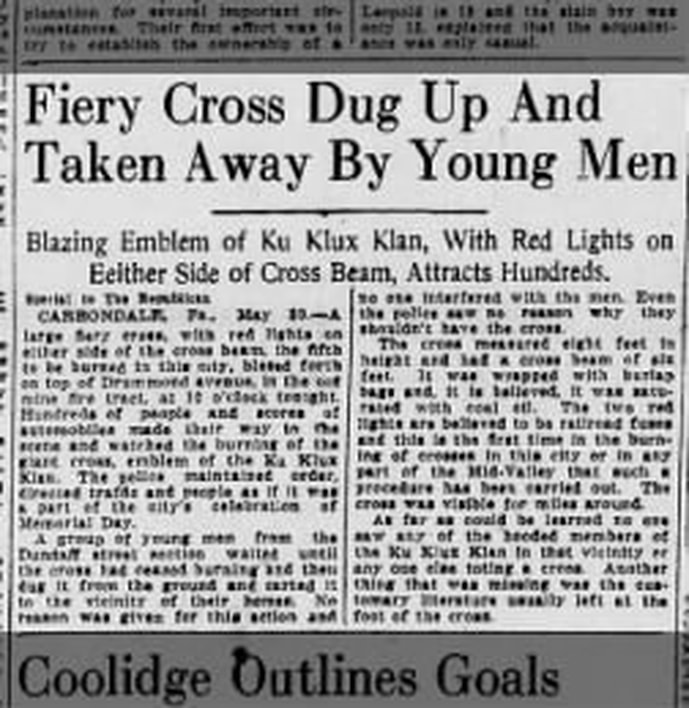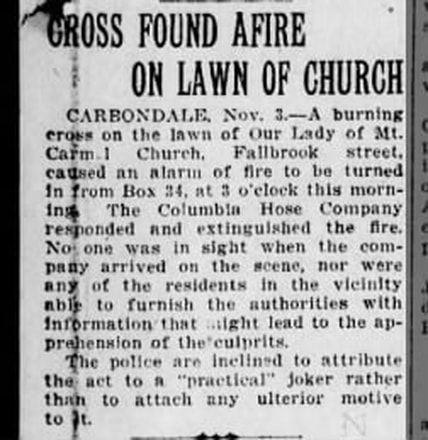The City where they dug more dirt than had been dug for the Panama Canal
Carbondale City History
--incorporated in 1851 from Carbondale Township as the first city within the anthracite region of the Commonwealth. The area was acquired by William and Maurice Wurts of Philadelphia as partial payment for a government contract to supply army clothing during the War of 1812. The name Carbondale is derived from the presence of coal deposits in the area, "the dale or valley where coal is found." The
first underground coal mine in the United States opened in Carbondale, known locally as the "Pioneer City." The Wurts brothers formed the Delaware and Hudson Canal Company to transport the coal to Honesdale via a gravity railroad and then to New York by canal.
Carbondale Township History
--created in 1831 from Blakely and Greenfield Townships. The pioneer settler of the township was David Ailsworth, who came from Rhode Island in 1802.
http://www.lackawannacounty.org/uploads/COUNTY_LINES_2008.pdf
David Aylsworth's (variant spelling) wife Ruth is buried in the sorely neglected early American Meredith Cemetery. It is one of only two inscribed tombstones; the other being Thomas Meredith's infant son. Thomas Meredith Sr. was the son of Samuel Meredith the Treasurer of the United States with Secretary of the Treasury Alexander Hamilton. His vast land holdings granted as payment for his financial support of the American Revolution included the land currently owned and conserved by this author.
...the powerful Delaware and Hudson Canal Company in the mid-1820s. This corporation, the largest of its time, had big plans for Carbondale. Originally, the company intended the small community to become the grand emporium of northeast Pennsylvania.
Carbondale had important advantages. It was close to the rich anthracite reserves of Lackawanna County and yet it was also not too far from the major market in New York City. The nearby D & H Canal and gravity railroad guaranteed that Carbondale would play a central role in the movement of Pennsylvania coal from mines to markets. It also led to many "linkage industries" that developed around anthracite production: small shops that specialized in much-needed services, like repairs, or parts. The population in Carbondale grew quickly and soon it was twice the size of more-established Wilkes-Barre.
Carbondale, however, never quite achieved the status its founders had envisioned. There was a multitude of reasons for the community's eventual decline, including a weak municipal infrastructure and an almost complete economic reliance on anthracite. The result was a dangerous and dirty place, "among the dingiest," according to historian Burton Folsom, of some very dingy, nineteenth-century industrial cities.
The underground mines, once the pride of Carbondale, also eventually haunted the troubled community. During the twentieth century, a fire erupted in one of the city's abandoned mines that burned for thirty-three years before it was finally extinguished.
http://explorepahistory.com/hmarker.php?markerId=1-A-E9
Over the years the numerous efforts to extinguish the mine fires has resulted in more dirt being dug than for the Panama Canal.
Information concerning one of the mine fires is available in the 2011 book: The West Side Carbondale Pennsylvania Mine Fire by Kathleen Purcell Munley.
The novel Hollow Ground by Natalie S. Harnett was inspired in by Carbondale mine fires. http://natalieharnett.com/hollow-ground/
--incorporated in 1851 from Carbondale Township as the first city within the anthracite region of the Commonwealth. The area was acquired by William and Maurice Wurts of Philadelphia as partial payment for a government contract to supply army clothing during the War of 1812. The name Carbondale is derived from the presence of coal deposits in the area, "the dale or valley where coal is found." The
first underground coal mine in the United States opened in Carbondale, known locally as the "Pioneer City." The Wurts brothers formed the Delaware and Hudson Canal Company to transport the coal to Honesdale via a gravity railroad and then to New York by canal.
Carbondale Township History
--created in 1831 from Blakely and Greenfield Townships. The pioneer settler of the township was David Ailsworth, who came from Rhode Island in 1802.
http://www.lackawannacounty.org/uploads/COUNTY_LINES_2008.pdf
David Aylsworth's (variant spelling) wife Ruth is buried in the sorely neglected early American Meredith Cemetery. It is one of only two inscribed tombstones; the other being Thomas Meredith's infant son. Thomas Meredith Sr. was the son of Samuel Meredith the Treasurer of the United States with Secretary of the Treasury Alexander Hamilton. His vast land holdings granted as payment for his financial support of the American Revolution included the land currently owned and conserved by this author.
...the powerful Delaware and Hudson Canal Company in the mid-1820s. This corporation, the largest of its time, had big plans for Carbondale. Originally, the company intended the small community to become the grand emporium of northeast Pennsylvania.
Carbondale had important advantages. It was close to the rich anthracite reserves of Lackawanna County and yet it was also not too far from the major market in New York City. The nearby D & H Canal and gravity railroad guaranteed that Carbondale would play a central role in the movement of Pennsylvania coal from mines to markets. It also led to many "linkage industries" that developed around anthracite production: small shops that specialized in much-needed services, like repairs, or parts. The population in Carbondale grew quickly and soon it was twice the size of more-established Wilkes-Barre.
Carbondale, however, never quite achieved the status its founders had envisioned. There was a multitude of reasons for the community's eventual decline, including a weak municipal infrastructure and an almost complete economic reliance on anthracite. The result was a dangerous and dirty place, "among the dingiest," according to historian Burton Folsom, of some very dingy, nineteenth-century industrial cities.
The underground mines, once the pride of Carbondale, also eventually haunted the troubled community. During the twentieth century, a fire erupted in one of the city's abandoned mines that burned for thirty-three years before it was finally extinguished.
http://explorepahistory.com/hmarker.php?markerId=1-A-E9
Over the years the numerous efforts to extinguish the mine fires has resulted in more dirt being dug than for the Panama Canal.
Information concerning one of the mine fires is available in the 2011 book: The West Side Carbondale Pennsylvania Mine Fire by Kathleen Purcell Munley.
The novel Hollow Ground by Natalie S. Harnett was inspired in by Carbondale mine fires. http://natalieharnett.com/hollow-ground/
Mine Fire Stories from the early 1900's
The Scranton Republican, March 7, 1908, p.3 :
The Scranton Truth, May 9, 1911, p.1:
Wilkes-Barre Times Leader, August 20, 1920 p.7:
Mine Fire Stories from the early 2000's:
2002 - Mine fires continue ...."And on the outskirts of Carbondale, 15 miles from Scranton, a mine fire moving faster than Centralia's forced federal engineers two years ago into a costly emergency effort to cut it off. They still monitor the site for a week each month, unsure that the fire is truly contained."
The danger to gas lines currently being constructed across the northeast is already a reality for Pennsylvanians in the soft coal mines:
"In Plum, a Pittsburgh suburb, a mine fire has come within 800 feet of natural gas wells on the edge of a public park. Last month, the state began a yearlong, $1.2 million effort to dig out all the burning coal, an estimated 367,000 cubic yards."
The Baltimore Sun, August 29, 2002 http://articles.baltimoresun.com/2002-08-29/news/0208290377_1_mine-fire-coal-fires-coal-mine
2015 - fire still burning : On privately owned land in the Carbondale area $8,947,731.84 was provided by the federal and state governments to extinguish and reclaim land damaged by mine fires. See presentation by Pennsylvania Department of Environmental
Protection: http://files.dep.state.pa.us/RegionalResources/NERO/NEROPortalFiles/PowderlyCreekMineFirePresentation.pdf
As of Sept. 2016 - fire still burning: http://paenvironmentdaily.blogspot.com/2016/09/powderly-mine-fire-reclamation-will.html
Lithuanians in Carbondale - The "Other Element"
Locating information on Lithuanian Americans In Carbondale was difficult. This author relied on local resources - largely personal experience and newspaper stories. Lithuanian Americans were present, in strong enough numbers to have a speech presented in Lithuanian at a Labor Demonstration that took place during the 1902 Anthracite Coal Strike at the Carbondale Semi-centennial Jubilee. The demonstration included nearly 2,000 participants who came to hear the President of the UMW of A,, John Mitchell, Mother Jones and other noteworthy union organizers. The Scranton Tribune newspaper edition of September 4, 1901 made no mention of the speech in Lithuanian. The Scranton Republican did, with the distinctive sub heading below:
World War I assistance effort:
Although there was no Lithuanian parish in Carbondale, St. Anthony's Parish in Forest City was @ 6 miles away and several Polish churches in closer nearby towns such as Simpson and Mayfield drew the Lithuanian Roman Catholics from Carbondale. A funeral notice for Lithuanian coal miner Michael Butsavage in the July 27, 1925 edition of The Scranton Republican bears that out:
